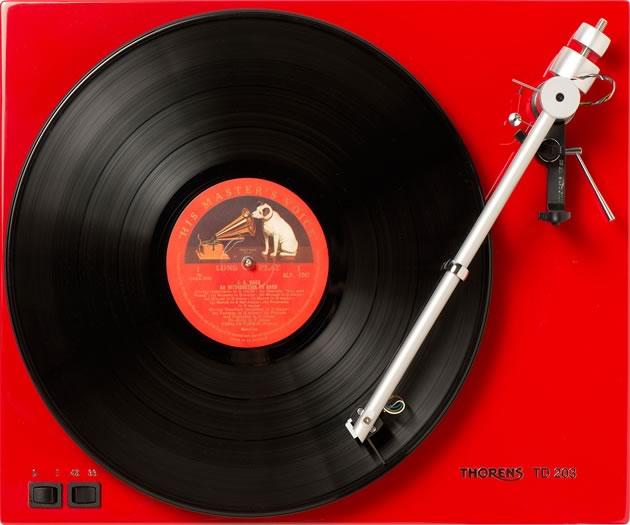An Affinity for Analog
Steeped in digital culture, generation Z and millennials are hungry for vinyl records, processed film, paper journals and real books as the ultimate antidote to a screen-based world.
While others rack up the streaming hits for their favourite artists on Apple Music and Spotify, 17-year-old Hanna Bulpit has a vinyl collection crossing the 200 mark. Sixteen-year-old Flora Dickison will defend her paper daybook and handwritten school notes against all Google calendars and cloud-based docs. And 14-year-old Daisy Gingerich has a bedroom wall plastered with 1970s-style Polaroid and printed photos, despite owning a new iPhone with a fabulous camera and storage to spare.
And why shouldn’t they? These representatives of generation Z (born 1997 to 2016, or 12 to 27 years of age) enjoy the best of both worlds, and in the process might just set an example for the rest of us. Like flowers growing toward the light, they respond positively to a seemingly warmer sound emanating from vinyl, the memory-boosting benefits of old-fashioned pen and paper, and the tactile quality of printed photos.
These aren’t the Luddite railings against digital encroachment by some members of the baby boom or silent generation nostalgic for the radio, broadcast television or records of their youth. This younger, often digital-native cohort finds balance and respite in experimenting with analog media, revelling in all its inherent clunky or cumbersome design – design that digital evangelists optimized into thin air. In the nouveau analog worldview, damage-prone records, heavy notebooks and yellowing photographs represent an unhurried, fully conscious humanity.
Youngsters who grew up with devices in their hands the way their parents once clutched baseball cards or Cabbage Patch Kids now select whichever modality works best for them in the moment. Need to send a quick message? Text, of course. Need to tap into a state of mindfulness? Touch a physical photo that you can’t manipulate, listen to a song that can’t be skipped, visit the library and pick up a book, or enjoy the kinesthetic appeal of pen marking paper.
Their tactile playground comes as a relief to experts in the field of connection and mental health, like Muskoka-raised Katherine Martinko, a digital-minimalism specialist and author of Childhood Unplugged: Practical Advice to Get Kids Off Screens and Find Balance. She writes, “As far as developing resilience and capability goes, screens become a crutch for children, a literal screen behind which they can hide. It enables them to avoid face-to-face conversation. Time spent on screens is time spent not doing other things…”
Shake it like a Polaroid
I must admit to being heartened by seeing my own daughter, Daisy, age 14, embrace the world of 1970s-style instant photography. Her chosen media are Polaroid and Instax film pictures, emerging with the telltale whirring noise from colourful cameras.
“My friends and I like taking instant photos,” Daisy says, as she flips through her photo collection housed in Instax-sized photo albums, or from a collection of prints strewn across her bed. “You get to see the print within seconds and it’s fun to decorate my room with the images – that never happens with photos on my phone. Plus each one is slightly different, so it’s fun to pick and choose.” Daisy’s room screams teen girl from the hanging vines to the grid duvet cover, fluffy blankets and plants, and yet the photos are individual to her. Instax prints are vibrant captures of friends at the beach, birthday parties, families and sunsets, adding a punch of life to the minimalist grey walls.
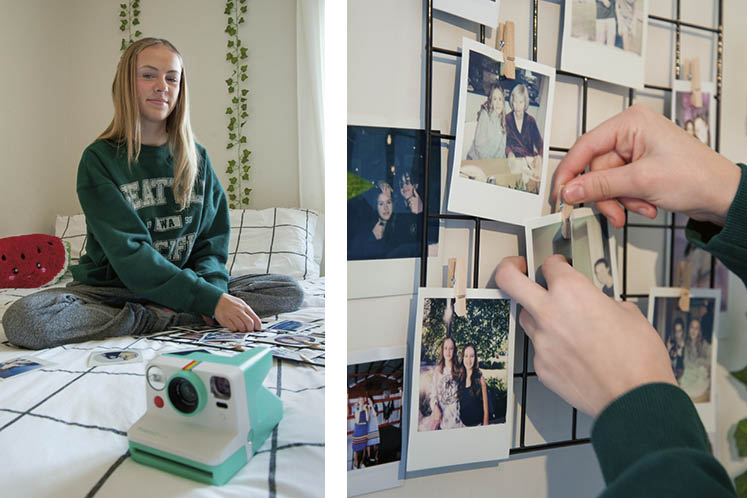
I personally love the slightly vintage hues of her Polaroid snaps of our cottage and family gatherings. They remind me of my earliest childhood photos in the mid-’70s and into the ’80s. In my generation X circle, Polaroids evoke pleasing nostalgia at a time when memories of the past seem more comforting than the terrifying speed at which life now seems to travel.
I am not the only parent who has seen an interest in film photography in their children, according to Michael Strachan, who has owned F-Stop Foto & Frame in Orangeville since 2016. He says in the past three years his business in film, instant cameras and processing has more than doubled and the demographic has shifted much younger.
“There have always been customers who find a random roll of film at home and want it processed just to see what’s on it,” he says. “But younger clients have found a camera belonging to their grandparents, or on eBay or at a hock shop, and they’re buying new rolls of film and wanting them developed.” Michael notes this is more than just a passing fancy. They might try film photography because their friends are doing it, but it quickly becomes a passion and a lesson in patience, rewarded by the fun of the reveal.
Play the record
Perhaps the poster child for the analog movement, though, is the vinyl record. But this isn’t just your dad’s hobby or a trip down memory lane. Hanna was younger than most when she started collecting in Grade 6 – just an 11-year-old tween, but already with a definite feel for what she liked.
“As I got more into music, I heard about vinyl and bought a record player. I really liked how they sounded. I feel like when listening to vinyl the music feels more natural and you hear less of the digital part experienced when listening on your phone,” she says.
Like her fellow analog aficionados, she is also drawn to records as physical objects. “I love how every album cover is different and how some are incredibly detailed and unique. It’s also really fun how the vinyl itself can come in so many different patterns and colours.”
Hanna’s tastes are as diverse as the album art she appreciates. She likes rap and R&B but her favourites for vinyl listening are rock or blues: BB King, Jimi Hendrix, Billy Joel and Stevie Ray Vaughan. “With these older genres of music, I feel like you can really hear the instrumentals on the vinyl in more detail – they’re both smoother and livelier. It’s interesting being able to hear the difference in music production from a long time ago compared to how it is now.”
While Hanna appreciates older artists, her contemporaries are flocking to buy records from contemporary icons. Not only did Taylor Swift make headlines for including a vinyl release of her October 2023 album, 1989 (Taylor’s Version), she also sold more than a million copies in only a few months, making it the best-selling vinyl album of 2023 in America.
“Vinyl has always been popular, but in the last five years we’ve seen the highest sales figures ever,” says Perry Joseph, owner of Aardvark Music & Culture in Orangeville. “Records have captured or recaptured the hearts of people of all ages. I’ve been selling records for 14 years, starting with some of my own collection, and I have customers that range from 12 to 70 years of age,” says Perry.
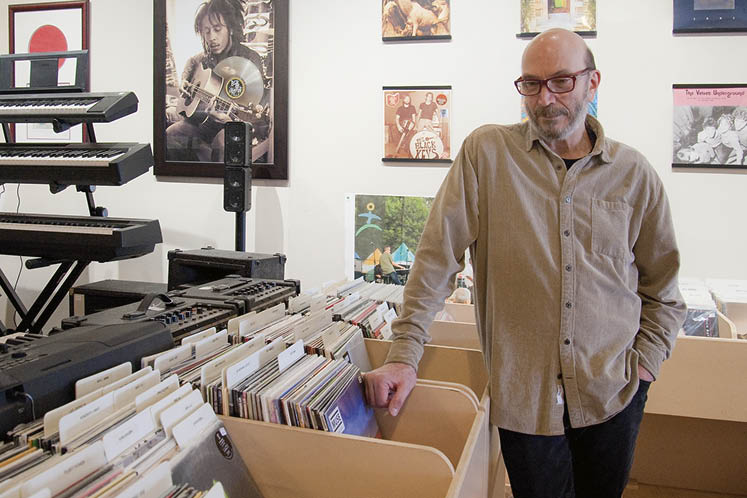
One of his customers is John Farrugia, a Mono sculptor who moonlights as a reggae DJ. John spins vinyl exclusively, placing him in the minority in this age of digital music when a DJ is more likely to be armed with a laptop than a turntable. For John the distinctive graphic designs of his records are part of his process. “The colour and artwork help me catalogue every song and how it will fit into a playlist. I wouldn’t get that via scrolling through my computer.”
John, a gen-Xer, is passing his love of analog music on to his son, Noah, who, at nearly two, adores flipping the switches and turning the knobs on his dad’s hi-fi system, while decked out in miniature safety headphones.
Another trained musical ear, Sara May of local band Falcon Jane, is releasing her spring album on vinyl – the second time she’s done so.
“Choosing an album, and then putting it on your record player, is a purposeful action. It gives the listener autonomy, connects you to the artist and can spark conversation with your fellow listeners,” says the 32-year-old, who lives in Hockley Valley. “I work hard writing and producing, and it’s nice to see it in a physical form versus simply existing as a digital file somewhere on the internet. It’s a great feeling to hold one of my records and think, ‘I made that.’”
Paper redux
For Grade 11 Orangeville student Flora, analog acts as a tether to the more natural world of real-life experiences. While she easily navigates digital productivity tools, she prefers to put her physical school planner to work at the family’s solid wood dining table, enjoying the glide of colourful gel pens onto paper.
“My paper daybook is very useful for planning ahead for school trips, concerts and events, and due dates. And I love to dive into my extensive collection of washi paper tape to add labels, make stickers or further personalize an inexpensive planner by covering it completely in fun patterns.” Her tips for limiting the expense of analog are to search thrift stores and back-to-school sales.
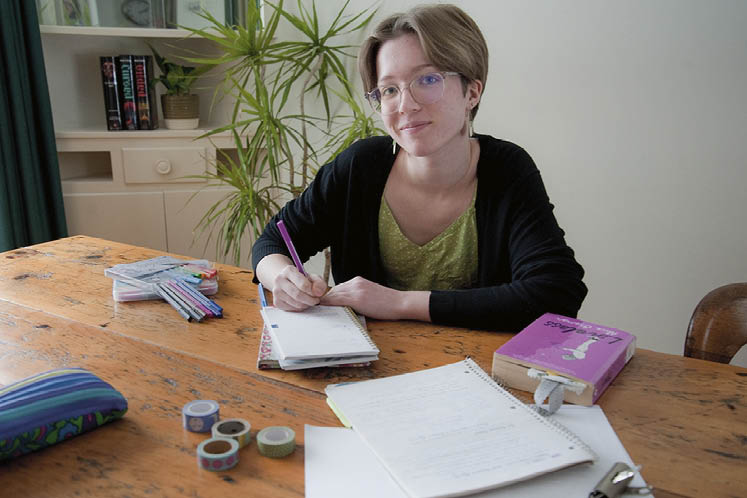
Flora also knows about the research-backed effectiveness of making paper study notes. The physical act of writing notes, events and ideas down on paper improves knowledge- and memory-processing, according to many studies, including one out of the University of Tokyo. There researchers found “writing on physical paper can lead to more brain activity when remembering the information an hour later.” The researchers added that “the unique, complex, spatial and tactile information associated with writing by hand on physical paper is likely what leads to improved memory.”
Digital planners and notes are handy when you’re on the go, but when time allows, “analog versions are always superior, in my opinion,” says Flora. Her Grade 9 notes were works of art in black ink with pastel highlights for key words. Now, with less time to spare, she favours a mechanical pencil for notes but still adds pops of marker for emphasis. She has branched out into colour-coded flashcards for biology.
Sarah King of Inglewood is another fan of using analog media to process and retain information. She studied graphic communications management at Toronto Metropolitan University, thinking she would work in a digital field, but after she found herself interning for Fuji Film and marketing large format print presses sold to print magazines, she embarked on a 15-year career in print marketing and advertising. “Prospective employees would say that no one knew print like I did, and they wanted me to focus on that less crowded and often more effective space,” Sarah laughs.
Sarah and her husband, Kris, both millennials (the cohort born between 1981 to 1996, now ages 28 to 43), doubled down on their analog itch and opened Erin’s Rural Commons in 2022. (Kris maintains one foot in the digital world, working in digital TV and film.) The business houses retail shops, services and a serene coworking space. Real life has a strong ROI, it turns out. Customers visit their stationery shelves for paper wall calendars, planners, journals such as the beloved Leuchtturm1917, pens and stickers.
“Moms are delighted to see the stickers and feel the peel-back pages of the retro-style sticker books. Even if their kids aren’t interested, they end up buying the items for themselves,” Sarah says. “It’s such a feel-good, nostalgic pull that is the perfect antidote to the digital drift we all experience.”
Sarah notes their paper greeting cards are a big hit too. I’m reminded of sending kitschy vintage Florida postcards home from a trip last winter. Their arrival in my stepdaughters’ university houses caused quite a stir – apparently none of her collection of housemates had ever seen a mailed postcard before and were quite taken by the experience, a moment of connection a text or email would have bypassed.
The pull of “old school”
Back in Flora’s preferred analog habitat, the teen pursues another slow pastime: the intentional act of reading a physical book. “I could never read an e-book,” she says. “Physical novels are much more enjoyable, as I can see my progress, feel the pages at my fingertips and smell the scent of the slightly yellowed pages.”
Curled up on her comfortable couch, Flora enjoys diving into a dystopian fantasy novel as a break from the real world, which for her is increasingly and inevitably digital. Choosing to pause and experience the physical feedback of her paper notes, books or planners is a welcome haven. When the cyber world seems a bit too intense, returning to a simple time – especially one appreciated and fostered by gen-X parents who grew up mostly analog – is a rejuvenating and accessible retreat. So chalk one up for the wisdom of the silent generation and the boomers, after all.
“With technology ever-changing and growing, I know that many teens my age are starting to see how nice the ‘old school’ ways really are,” says Flora. “They’re more creative, flexible to our own personalities, and a perfect way to escape.”
Related Stories
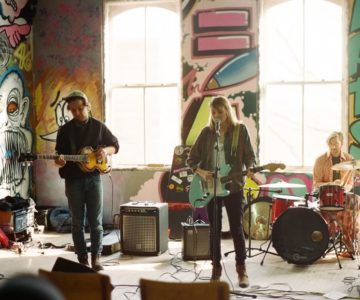
Sara May’s Homecoming
Nov 24, 2020 | | ArtsWhen the musician came back to Orangeville, she was skeptical about the small town she’d grown up in. What she discovered was a creative “dream space.”
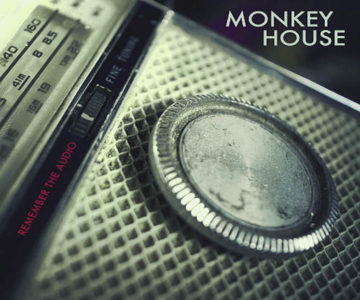
The Year in Music: 2022
Nov 20, 2022 | | ArtsOur annual review of new recordings by local musicians with flavours of rock, country, jazz and more.
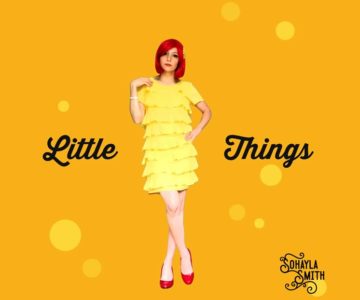
The Year in Music: 2021
Nov 29, 2021 | | ArtsOur annual review of recordings by local musicians taps into a collaborative music scene that has stayed busy despite a pandemic keeping many apart.



